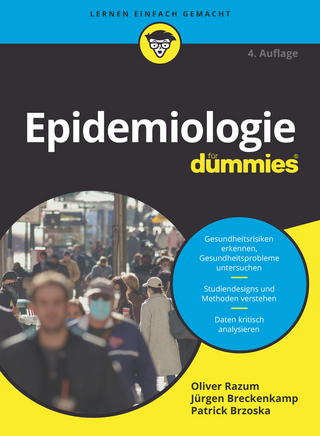
Statistics in Small Doses
Seiten
1995
|
3rd Revised edition
Churchill Livingstone (Verlag)
978-0-443-04542-4 (ISBN)
Churchill Livingstone (Verlag)
978-0-443-04542-4 (ISBN)
- Titel ist leider vergriffen;
keine Neuauflage - Artikel merken
This text aims to provide the reader with a clear understanding of statistics, particularly in a medical context. The book has been structured to make it easy to learn from, with continual questions and answers designed to continuously test the reader's grasp of the subject matter.
Many medical and pharmaceutical workers have very little knowledge of statistics. Yet statistics is one of the tools must commonly used in their field. This book aims to give the reader a clear understanding of statistics, particularly in a medical context.The book has been carefully structured to make it easy to use and to learn from. The numerical examples used are simple, to ensure the reader grasps quickly the underlying principles, and the first part of the book is particularly easy reading to encourage the reader initially. The main part of the book dispenses in formation in small doses called 'frames' with questions and answers designed to continously test the reader's grasp of the subject matter. This makes the book particularly useful for self-testing - a powerful way to learn. Moreover, many of the answers feature further explanation or comment to give background to the point being made.As a whole, the book is meant to be read from start to finish (not 'dipped into') so that each point leads on logically, building up the reader's knowledge sequentially.
However to cement that knowledge and help revision, each chapter ends with revision summaries covering fully the chapter's content. This third edition has been fully revised and much of the material is new, for example chapter 19 (on simple linear regression) 21 (nonparametric methods) and 22 (statistical computing.). The book retains the strengths of previous editions and will give the reader a thorough understanding of this vital subject. Features: * An accessible guide to understanding this vital subject * Carefully structured to guide the reader through the subject in a user-friendly way and ensure comprehension * No complicated mathematics - to ensure the reader grasps the basic concepts quickly * Features self-testing questions and discursive answers giving more detail and a better understanding * Fully revised for this edition
Many medical and pharmaceutical workers have very little knowledge of statistics. Yet statistics is one of the tools must commonly used in their field. This book aims to give the reader a clear understanding of statistics, particularly in a medical context.The book has been carefully structured to make it easy to use and to learn from. The numerical examples used are simple, to ensure the reader grasps quickly the underlying principles, and the first part of the book is particularly easy reading to encourage the reader initially. The main part of the book dispenses in formation in small doses called 'frames' with questions and answers designed to continously test the reader's grasp of the subject matter. This makes the book particularly useful for self-testing - a powerful way to learn. Moreover, many of the answers feature further explanation or comment to give background to the point being made.As a whole, the book is meant to be read from start to finish (not 'dipped into') so that each point leads on logically, building up the reader's knowledge sequentially.
However to cement that knowledge and help revision, each chapter ends with revision summaries covering fully the chapter's content. This third edition has been fully revised and much of the material is new, for example chapter 19 (on simple linear regression) 21 (nonparametric methods) and 22 (statistical computing.). The book retains the strengths of previous editions and will give the reader a thorough understanding of this vital subject. Features: * An accessible guide to understanding this vital subject * Carefully structured to guide the reader through the subject in a user-friendly way and ensure comprehension * No complicated mathematics - to ensure the reader grasps the basic concepts quickly * Features self-testing questions and discursive answers giving more detail and a better understanding * Fully revised for this edition
Types of Results: Counts and Measurements. Illustrating Counts. Illustrating Measurements. The Normal Distribution. Notation. Measuring the Middle. Measuring the Variation. What Correlation Means. Measuring Correlation. Populations and Samples. Fairness in Sampling: How to Be on Target. What Happens When We Take Samples. The Laws of Chance. Standardising the Normal Curve. Ideas Behind Significance Tests. Simple Tests with Z. Simple Tests with Student's T. Testing for Real Correlation. Simple Linear Regression. Simple Tests with X2. Nonparametric Tests. Some Brief Remarks on Statistical Computing Appendix 1 Answers to Practical Examples. Appendix 2 How Much Have You Learned?. Appendix 3 Tables
| Erscheint lt. Verlag | 21.11.1995 |
|---|---|
| Überarbeitung | Philip M. North |
| Zusatzinfo | 150 ills. |
| Verlagsort | London |
| Sprache | englisch |
| Maße | 140 x 216 mm |
| Gewicht | 354 g |
| Themenwelt | Mathematik / Informatik ► Mathematik ► Angewandte Mathematik |
| Mathematik / Informatik ► Mathematik ► Statistik | |
| Studium ► Querschnittsbereiche ► Epidemiologie / Med. Biometrie | |
| ISBN-10 | 0-443-04542-9 / 0443045429 |
| ISBN-13 | 978-0-443-04542-4 / 9780443045424 |
| Zustand | Neuware |
| Informationen gemäß Produktsicherheitsverordnung (GPSR) | |
| Haben Sie eine Frage zum Produkt? |
Mehr entdecken
aus dem Bereich
aus dem Bereich
ein überfälliges Gespräch zu einer Pandemie, die nicht die letzte …
Buch | Hardcover (2024)
Ullstein Buchverlage
24,99 €


